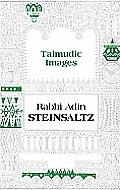 by Rabbi Adin Steinsaltz
by Rabbi Adin Steinsaltz
Adin Steinsaltz is one of the most versatile and wide-ranging writers in Judaism today. In areligion that places a premium on learning, his works are all geared to teaching andencouraging a general audience. After several books on chasidic thought, he returns to theTalmud with a series of character sketches, Talmudic Images.
The Talmud is both the source and the model for the Jewish “Great Conversation” of religious,social, and philosophical ideas, and the rabbis are its earliest participants. Its associativeorganization and detailed debates often leave one confused. The rabbis can seem mere namesattached to this opinion or that. The text treats them as if they all knew one another, eventhose living centuries apart. It is easy to forget that they were actual people, distinctivein both circumstance and temperament. As in his previous book, Biblical Images, Steinsaltz tries to bring their individual personalities into relief.
This idea is not entirely new. Milton Steinberg’s As a Driven Leaf fictionalizes thelife of Elisha ben Avuyah. But Steinberg admits that he changes or ignores aggadic accountsto suit his story.
By contrast, Steinsaltz’s sketch is rigorously faithful to the Talmudic text, trying to accountfor all the evidence presented therein. However, he is not writing a reference book, such asShulamis Friedman’s Who’s Who in the Talmud. Steinsaltz’s book is comprehensive intime and geography, chronologically profiling Palestinian and Babylonian rabbis over a periodof 400 years.
We get to know a wide cast of characters. While most of us have heard of Hillel, Shammai, andAkiva, the majority of talmudic discussions are actually driven by debates between Rabbi Yohananand Rabbi Shimon ben Lakish, or Resh Lakish.
When Resh Lakish is living in the world of the professional gladiator, Rabbi Yohanan has established himself as a leading scholar. Their meeting, a test of wills, and Rabbi Yohanan’ssuccess in luring Resh Lakish back to the study house, is among the most dramatic in aggadicliterature. Their story of their deaths is among the most tragic. As they studied andargued, they fueled one of the most creative periods in rabbinic history.
Fittingly, Steinsaltz finishes with Rav Ashi, the last of the Talmudic rabbis, and traditionallyregarded as its initial redactor. While the reduction of the Oral Law to written text hadbegun several centuries previous, with the Mishnah and Rabbi Judah HaNasi, the Oral traditionhad remained substantially memorized. Writing it down must have been as wrenching a decisionfor Rav Asi as it had been for Rabbi Judah. The style and content of the Talmud reflect RavAshi’s conscious attempt to determine not only the proper subjects for future debate, but alsothe form that debate should take.
Steinsaltz walks a fine line in these essays. He manages to give the rabbis the benefit of thedoubt without glossing over or rationalizing their flaws. Doing so would defeat his purpose,placing Talmud study beyond the abilities of the average student.
As an aide, the Talmudic sources appear fully quoted in extensive footnotes. From these,Steinsaltz is able to synthesize convincing and realistic portraits.